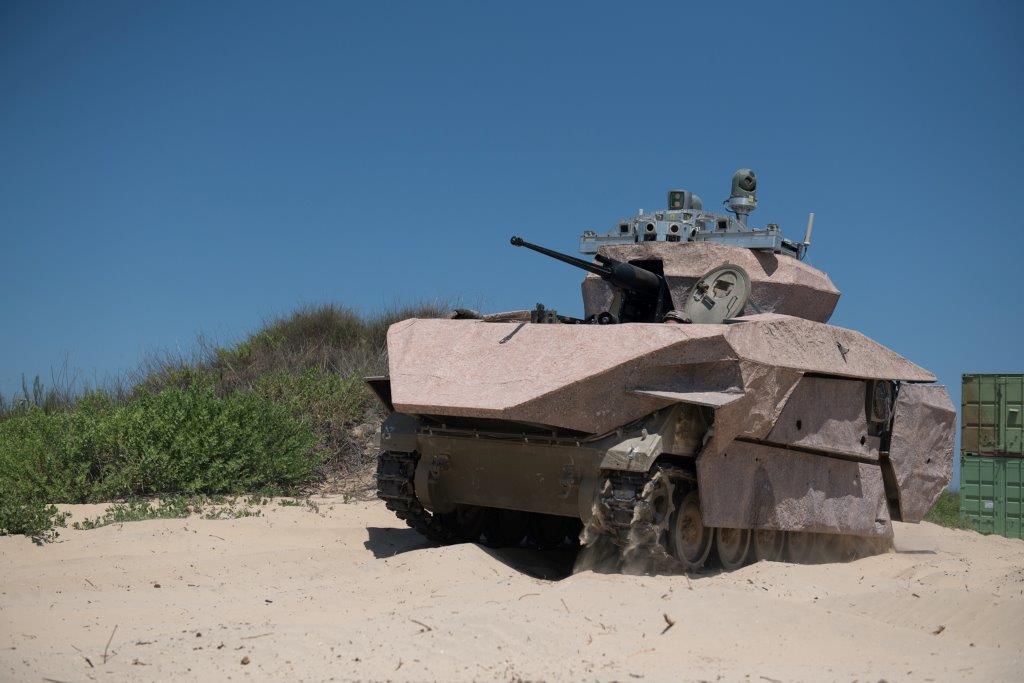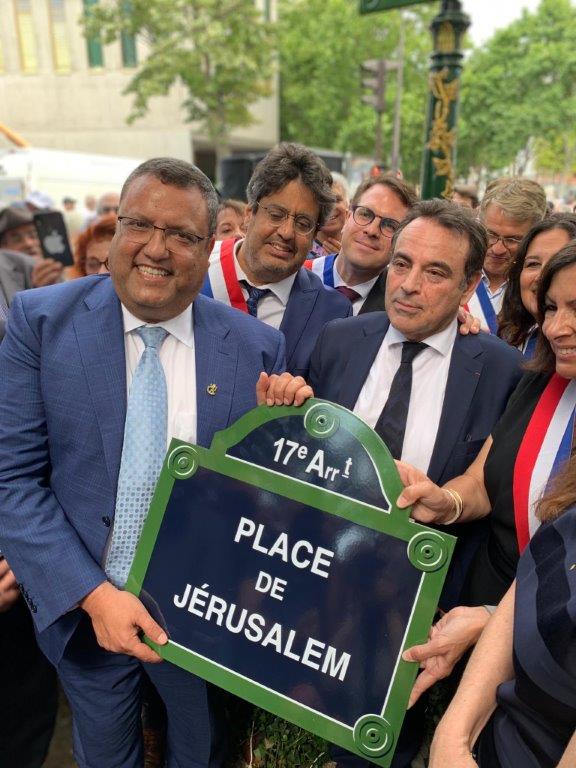- Details
- Written by Ministry of Defense Spokesperson’s Office

The Carmel Program: The Directorate of Defense Research and Development at the Ministry of Defense Reveals the Technology that will be Used in the Combat Vehicle of the Future
The combat vehicle of the future will be upgraded with artificial intelligence, autonomous and automatic capabilities. It will be compact, agile, effective, survivable, maintainable and affordable and will be operated by only two combat soldiers. Three defense industries (Elbit Systems, Israel Aerospace Industries, and Rafael), have reached the final phase of development. Today upon the completion of a month of trials, three major technological concepts have been presented, among others. These advanced platforms will be integrated into the IDF’s current and future armored vehicles - both manned and autonomous.
Today (04.08.19), the Directorate of Defense Research and Development (DDR&D), in the Israel Ministry of Defense, and the Office of the Head of the Armored Corps in the IDF, completed a demo event to reveal the platforms developed within the framework of the Carmel Program. The program does not produce a new vehicle, but rather a breakthrough vision for combat, based on advanced technology. The program focuses on autonomous and automatic maneuvering, artificial intelligence and more. The event was held in the presence of the Ministry of Defense Director General, IDF Deputy Chief of General Staff, Commander of the Ground Forces, Head of the Directorate of Defense Research and Development in IMOD, and senior officials from the IDF and defense establishment.
The Carmel Program was launched three years ago as a multi-year program for the development of advanced technology to upgrade the IDF’s combat vehicles – producing an agile, effective, innovative, compact, easy-to-maneuver vehicle with relatively low costs. The purpose of the program was to develop the technology necessary for the “combat field of the future,” maintaining operational superiority via technological superiority.
During the first phase of the Carmel Program, a significant challenge was presented to the three major defense industries in Israel: to prove the feasibility of an AFV that is operated by only two combat soldiers, with a closed hatch. Following a lengthy evaluation process, the Ministry of Defense selected three Israeli defense industries to continue the development program: Rafael, IAI, and Elbit Systems.

Each industry was asked to develop its own technological concept, that would transform and upgrade the interior part of the IDF’s combat vehicles to an advanced cockpit (much like a fighter jet’s cockpit). The challenge: proving the feasibility of two soldiers conducting closed hatch operations and integrating technological capabilities that would enhance mission efficiency for the IDF’s maneuver forces. The advanced cockpit integrates autonomous capabilities (maneuvering, detecting targets, defense, etc.). In addition, the combat soldier enjoys multi-sensor fusion and 360-degree surround vision, high connectivity, and situational awareness. Ultimately, the soldiers are only required to make decisions that the mechanism cannot (yet) make by itself.
The industries took the challenge head on, employing experts in the field and introducing advanced technological infrastructure in the process. Each industry tested its solution throughout a period of a week, within a series of complex operational scenarios. A team of experts from the DDR&D evaluated the three concepts in accordance with predetermined criteria. The technological platforms proposed for the future AFV, employ a combination of advanced sensors, VR and AR mechanisms, AI technology to process information, and more.
Elbit Systems: Elbit Systems developed a technological concept for combat soldiers in the future AFV, operated by the Iron Vision “See-Through” Helmet Mounted Display (HMD). This is based on the technology that the industry developed for the F-35 fighter jet. The concept is underpinned by applying autonomous capabilities and Artificial Intelligence (AI), to accelerate decision making and facilitate target engagement with dramatically increased rapidity and accuracy. Using a Helmet Mounted Display (HMD) a crew of two combat soldiers operates the AFV under closed hatches, further enhancing capabilities and survivability. The AFV successfully demonstrated its capacity to function as an independent high fire-power strike cell, as a networked station for multi-spectral sensing and information fusion, as well as a base platform for operating additional unmanned systems.
Rafael: RAFAEL’s solution for the future combat fighting vehicle enables two crew members to perform their mission, in a fully protected closed hatch vehicle, with a breakthrough transparent cockpit design, enabling 360 degree situational awareness, using augmented reality for real-time battlefield information and data. This includes targets, Blue Forces, and other Points Of Interest (POI’s), as well as an autonomous mission support system, for autonomous mission planning, driving, and simultaneous operation of all vehicle weapon systems, all based on combat artificial intelligence capabilities.
IAI: IAI presented a platform based on the company’s family of autonomous systems and robotic tools, which are currently in wide operational use in Israel and around the world. The Carmel platform proposed by IAI, combines a panoramic display, individual control screens, and a control stick similar to a gaming console or “Xbox Joystick”. The autonomous capabilities in the combat vehicle are operated by a central, autonomous system, which integrates the various components in the platform and assists the human operator in processing information, focusing on critical threats, and making effective real-time decisions. The platform is based on AI technology to detect threats, enabling effective target engagement and weapon system management as well as autonomous driving in various terrains.
In addition to the aforementioned platforms, the DDR&D led a program to develop technological solutions that were not presented in the demo today. These platforms integrate the following capabilities: hybrid propulsion, cyber defense, active camouflage, multi-task radar, a system to identify troops, and more. The platforms that have reached an advanced stage in the development process, are already being integrated in the AFVs that the IMOD Tank and APC Directorate is developing and producing today.
The Carmel Program is based on breakthrough and innovative technologies on a global scale and the platforms developed by Israeli industries are garnering international interest. The technological capabilities tested in the Carmel Program have never before, been integrated into combat systems. The Carmel Program at the Ministry of Defense places the State of Israel at the forefront of the worldwide effort to develop advanced combat vehicles. This is made possible by the creativity and innovative capabilities of Israel’s defense industries. The results of the Carmel Program will serve as the technological and engineering infrastructure of both the manned and autonomous defense and combat tools of the future.
Photo Ministry of Defense Spokesperson’s Office
- Details
- Written by President’s Spokesperson’s Office

President Reuven (Ruvi) Rivlin yesterday, Monday 28 July 2019 / 25 Tammuz, hosted representatives of Accessibility Israel to mark the 20th anniversary of its establishment. Accessibility Israel works to change the perception of the public space and improve accessibility for people with disabilities. The president received a report summarizing 20 years the organization’s activities. Founder and president Yuval Wagner, and CEO Michal Rimon spoke at the event, which concluded with Orel Palomba singing the song ‘Ani VeAta / You and I’, accompanied by sign language and realizing her dream of singing at Beit HaNasi. She even received a presidential escort, as the president walked her, hand in hand, from her seat to where she sang for the people in the hall.
The meeting was the closing of a circle for the founder of the association, Yuval, who was injured in the course of his service as an Air Force pilot and wrote a letter to then-President Ezer Weizman explaining how difficult it was to move about in public spaces. 20 years ago, he was invited by Beit HaNasi to establish Accessibility Israel. Yuval, an Israeli Air Force pilot was injured in the course of his service in 1987, and remains paralyzed from the neck down and is a wheelchair user.
In preparation for the meeting, attended by guests with various disabilities, the Beit Hanassi security department underwent training with Accessibility Israel with the aim of adapting security checks and assistance for visitors with disabilities.
The resident opened the meeting by expressing his deep appreciation for Accessibility Israel and its founders, who made the vision of accessibility in Israel a basic and fundamental social duty. He spoke about how, when he was an MK, he met MK Ilan Gilon, who in one of his speeches coined the phrase ‘a society that does not care those who need help is unworthy of being called a society.’
"I was deeply impressed by his words, and since then quote this statement often," said the president, adding, "It is our duty to make an effort and to take care of all those who have physical or other disabilities. Accessibility should be taken for granted. It is not enough to legislate regarding accessibility, there must be regulations that are enforced.”
Yuval Wagner, founder, and president of the organization thanked the president and said, "It is unbelievable how a letter to the president created 20 years of activity to promote accessibility for people with disabilities. It is nothing less than a revolution. From a country that was absolutely not accessible – not physically, not socially and not in terms of services, to a state with legislated equality of rights and accessibility. 20 years on, Israel is much more accessible and allows those with disabilities to live better despite their limitations.”
Photo credit: Mark Neiman, GPO
- Details
- Written by Silvia Golan

On Thursday evening, June 13th, Debate for Peace celebrated a year of impressive achievements with a reception at the home of the Cultural Attache of the US Embassy, Elizabeth Fritschle. Dozens of students and teachers from the program were joined by diplomats and civil society leaders for an evening dedicated to youth empowerment, intercultural communication, and peace-building.
In tribute to the youth empowerment theme, the evening was student-led, with Michael Backlund, Neven Atawna, and Tal Zaidman introducing the speakers. After opening remarks from CAO Fritschle and Debate for Peace director Steven Aiello, four speakers were called up to present from the Empathy Storytelling project. Eliran Ben Yair, Sharehan Alwakily, Amit Weinstock, and Eman Otman each presented their Jewish or Palestinian partner’s story in passionate monologues. After all four had spoken, the floor was opened for questions from the audience.
Following the storytelling session, Eiman Darawshi, an English instructor and Model UN coordinator from Iksal high school, spoke about the impact that she has seen from Model UN on her students. She noted, in particular, her students who had been able to travel abroad, Shada Darawshi to Yale University for an MUN conference there, and Eman Otman to the Netherlands with the storytelling project.

An abbreviated Youth Moot Court simulation was then held, showcasing a project in which several Debate for Peace students participated. The moot court is one of several youth empowerment projects run by Avi Omer’s Social Excellent Forum, a close partner of Debate for Peace.
Following the presentations, Debate for Peace members were called up to receive awards for hard work and outstanding performance throughout the year. The students who received awards were Alon Mor, Amit Weinstock, Aviv Hanuka, Eliran Ben Yair, Eman Otman, Hannah Zohn, Mihal Mizrahi, Sharehan Alwakily; and Yafa Nassar. In addition to Jewish and Palestinian students visiting one another’s homes, some of the projects they worked on this year included organizing iftaar (breakfast meal) for hospitalized children from Gaza; presenting in their schools about what they’ve learned through Debate for Peace programming; presenting in Jewish schools about the perspective of Arab students as minorities in Israel, and a forum for Jewish and Arab students to meet, first discussing social topics online, and then meeting in person.
Steven Aiello, Director of Debate for Peace, told Diplomacy that “this program is changing lives and building future leaders. This year we engaged over 1,000 students and led six delegations abroad, and we couldn’t have done it without the continued support of the US Embassy in Israel!” He added his gratitude for Silvia Golan and the Diplomacy news portal www.diplomacy.co.il for providing coverage of Debate for Peace conferences and delegations throughout the year.
Photos by David Azagury US Embassy ( more pics at https://www.facebook.com/diplomacy.israel )
- Details
- Written by Jerusalem Muni

Today (Sunday, 30 June 2019), Jerusalem Mayor Moshe Lion inaugurated Jerusalem Square in Paris in the presence of Mayor Anne Hidalgo and the Israeli Ambassador to France, Aliza Bin-Noun, Head of the Consistoire, Joel Margi, the Chief Rabbi of France, Haïm Korsia, and the Chief Rabbi of Paris, Michel Gugenheim. The square is located in Paris's 17th arrondissement.
Mayor Lion: "I want to thank Mayor Hidalgo and the city of Paris for this beautiful initiative to name a square in honor of Jerusalem. This act strengthens the bond between our cities - two cities that have left their mark on the world. As Mayors, promoting tolerance, love, and peace in our cities is a top priority. We must do all in our power to create and ensure coexistence and companionship between different sectors and religious groups.”
Photo Credit: Jerusalem Municipality Spokesperson's Unit
- Details
- Written by Israel Ministry of Defense

The Israel Ministry of Defense has completed preparations for the opening of an Israeli exhibit at the world's largest aerospace trade exhibition. The International Paris Air Show will commence on Monday, June 17th, at the Le Bourget exhibition center. The show takes place at a time marked by an increase of defense budgets by the European members of NATO. The International Defense Cooperation Directorate (SIBAT), of the Israel Ministry of Defense, along with Israeli defense industries will exhibit advanced tactical UAVs, missiles, radars and more.
SIBAT, The International Defense Cooperation Directorate at the Ministry of Defense has completed preparations for the inauguration of an Israeli exhibit at the International Paris Air Show at Le Bourget, near Paris. This is the largest aerospace trade show and among the most important exhibitions in the world. Five of Israel’s leading defense industries will partake in the exhibition: Rafael, Elbit Systems, Israel Aerospace Industries (IAI), Aeronautics Defense Systems, and UVision. Two additional companies, Bet Shemesh Engines and BIRD Aerosystems will also participate in the exhibition.
Director of SIBAT, Brig. Gen. (Ret.), Yair Kulas - recently appointed to the position:
“The European Defense Market is among the most competitive and rapidly growing markets in the world. The European continent is encountering various security challenges including domestic security, counter-terrorism and border defense. The [show] is an opportunity for exporters and innovators to present their solutions, and this is particularly true for Israel, which is considered a global leader in defense technologies. The demand
for advanced Israeli technologies has been on the rise in Europe in recent years, and we will work hard, together with the Israeli industries, to maintain and enforce this trend.”
The products and technology that will be displayed at the Israeli exhibit:
Elbit Systems will reveal new technology in the fields of intelligence, aerial precision guided munitions, and civil aviation. Among the new systems:
The Hermes 45 is a new small tactical UAS that combines airborne and operational capabilities that are typical of large aircraft. The UAS offers a unique combination of extended range and duration with point launch and recovery, to and from land and maritime platforms thus enhancing Intelligence, Surveillance, Target Acquisition and Reconnaissance (ISTAR) capabilities at the brigade and division levels and also for naval squadron units.
The Rampage is a long-range, precise, supersonic missile.
The i-FMS is a flight management system that tackles the challenge that pilots face today with FMS operations- the need to propose changes to the FMS during critical phases of flight such as takeoff and landing.
IAI will unveil two new products:
The T-Heron is a tactical UAV suitable for missions undertaken by ground troops, coastal guards and similar forces.
The MS-MMR radar features new active and passive sensors to generate an enhanced aerial situation assessment.
Throughout the show, IAI is expected to announce new venues of business cooperation in various fields.
Rafael will reveal:
A new navigation system for fighter aircraft - the first in the world with electro-optic capabilities combined with SAR radar capabilities. The combination of these capabilities provides a broad response to a variety of environmental conditions.
The Iron Dome System - in its various forms: land, marine and mobile versions of the Iron Dome (i-Dome) - in which all system components are installed on a vehicle.
Le Bourget (Figures from 2017): Approximately 330 thousand square meters of exhibition space in the exhibition halls and outside area, 2,400 companies from 48 countries, 290 official delegations from the field of defense and government offices, 27 national pavilions, about 150,000 visiting professionals and about 200,000 visitors from the general public.
Photo Israel Ministry of Defense









